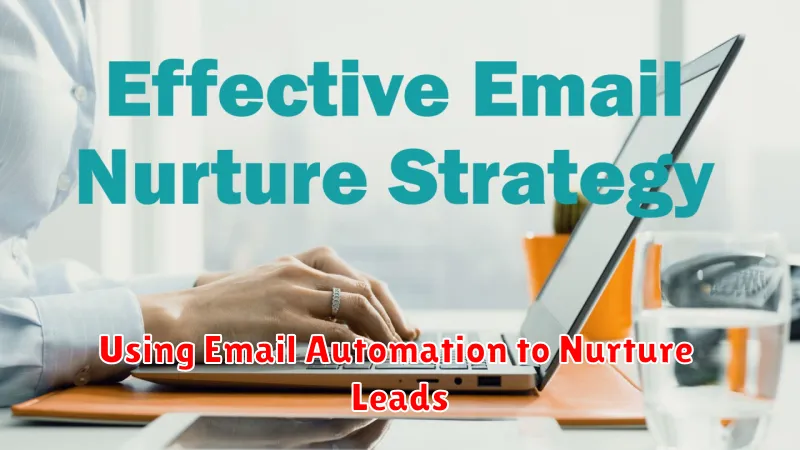In today’s competitive digital landscape, lead nurturing is paramount to converting prospects into loyal customers. Email automation offers a powerful solution for businesses seeking to cultivate meaningful relationships with their leads, guiding them through the sales funnel with personalized and timely communications. This article explores the strategic advantages of using email automation for lead nurturing, examining how it can enhance engagement, boost conversion rates, and ultimately drive business growth. Understanding the core principles of automated email sequences, targeted messaging, and effective lead scoring is essential for maximizing your return on investment in this crucial marketing strategy.
From welcome emails to post-purchase follow-ups, leveraging email automation for lead nurturing enables you to deliver the right message at the right moment, building trust and fostering deeper connections with your audience. Discover how to implement effective email automation strategies that resonate with your target audience, nurture qualified leads, and accelerate your sales cycle. We will delve into practical techniques, including segmenting your lead lists, crafting compelling email content, and analyzing key metrics to optimize your email marketing campaigns for optimal results.
What Is Email Automation?
Email automation is the automated sending of emails to subscribers based on pre-defined criteria and schedules. It removes the need for manual sending, allowing for efficient and targeted communication.
Instead of composing and sending individual emails, you create automated email sequences, also known as workflows. These workflows are triggered by specific actions or events, such as signing up for a newsletter or making a purchase.
Building a Lead Nurture Funnel

A lead nurture funnel strategically guides prospects through the sales process using automated email sequences. It begins with attracting top-of-funnel leads, often with valuable content like ebooks or webinars.
As leads demonstrate further interest, they move down the funnel, receiving more targeted content related to their specific needs and pain points.
Finally, bottom-of-funnel leads, who are sales-ready, receive personalized messages focused on product demos, pricing, and closing the deal.
Tagging and Segmenting Your List
Effective email automation relies on delivering the right message to the right audience. Tagging and segmenting your email list allows for this precise targeting.
Tags are labels you apply to individual subscribers based on their actions or characteristics (e.g., “downloaded ebook,” “attended webinar”). Segments are groups you create based on shared tags or other criteria (e.g., “all leads from the healthcare industry”).
By utilizing tags and segments, you can tailor your automated email sequences to deliver highly relevant content, improving engagement and conversion rates.
Setting Up Trigger-Based Workflows
Trigger-based workflows initiate actions based on specific subscriber activities. These triggers can include opening an email, clicking a link, downloading a resource, or submitting a form. Defining these triggers is crucial for delivering timely and relevant content.
For example, if a lead downloads a specific ebook, a trigger can be set to automatically enroll them in a workflow that sends a series of follow-up emails related to the ebook’s topic. This ensures targeted and effective lead nurturing.
Writing Effective Email Sequences
Effective email sequences nurture leads by providing valuable content and guiding them towards conversion. Each email should have a clear purpose and contribute to the overall narrative.
Start with a compelling subject line to grab attention. Keep the email copy concise and focused, highlighting key benefits. A strong call to action is crucial for driving engagement and moving leads to the next stage.
Personalization, segmentation, and testing are essential for optimizing email sequences and improving their performance.
Monitoring Engagement Metrics
Monitoring engagement metrics is crucial for optimizing your automated email nurturing campaigns. By analyzing key performance indicators (KPIs), you can gauge the effectiveness of your strategy and identify areas for improvement.
Track metrics such as open rates, click-through rates (CTR), conversion rates, and unsubscribe rates. These metrics provide insights into how leads are interacting with your emails and whether your content resonates with them.
Regularly reviewing these metrics allows you to refine your email content, subject lines, and targeting to maximize lead engagement and drive conversions.
Best Tools for Automation
Choosing the right automation tool is crucial for successful lead nurturing. Several platforms offer varying features and pricing.
Popular options include:
- Mailchimp: Known for its user-friendly interface and robust email marketing features.
- ActiveCampaign: Offers advanced automation workflows and CRM capabilities.
- HubSpot: A comprehensive marketing platform with a powerful automation engine.
- ConvertKit: Caters specifically to creators and businesses focused on audience building.
Consider your budget and required features when making your selection.
Avoiding Over-Automation Mistakes
While email automation offers significant advantages, excessive automation can negatively impact your lead nurturing efforts. Over-automation can lead to impersonal and irrelevant communication, driving leads away instead of nurturing them.
A common mistake is automating every single touchpoint. Strive for a balance between automated messages and personalized interactions. Consider using automation for initial welcome sequences and follow-ups, but incorporate manual touchpoints, like personalized emails or phone calls, for qualified leads.
Another pitfall is neglecting segmentation. Sending generic automated emails to all leads, regardless of their stage in the sales funnel, results in low engagement. Segment your audience based on their behavior and interests to deliver targeted and relevant content.
Testing and Optimization Tips
Continuously test and optimize your automated email sequences to maximize their effectiveness. This involves analyzing key metrics.
Focus on open rates, click-through rates (CTR), and conversion rates. Identify areas for improvement and experiment with different approaches.
Test subject lines, email content, call-to-actions, and sending times to determine what resonates best with your audience. Small changes can yield significant improvements.
When to Involve a Human Touch
While email automation excels at scaling lead nurturing, a human touch remains crucial for specific scenarios. Consider personalized intervention when leads demonstrate high engagement, such as frequently opening emails or clicking links related to specific products or services.
Complex sales often require direct interaction. A human sales representative can effectively address intricate questions, handle objections, and tailor solutions to individual needs, fostering stronger relationships and increasing conversion rates.

